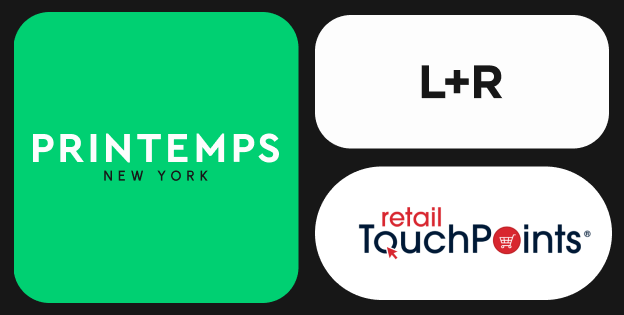DatoCMS, a leading headless content management system, recently published a customer story featuring L+R's work. This in-depth look highlights our collaboration with Printemps New York, showcasing how our team, led by Web Engineering Lead Maximilian Benner and Director of Engineering Ivan Leider, redefining in-store navigation for the luxury retailer's first US location at One Wall Street.
The project envisioned an experience that moved beyond traditional signage. We aimed for an integrated wayfinding system—digital signage designed to help customers navigate the space, discover events, services, and even locate features like pop-up shops, specials, restaurants, cafes, and bars—that felt deeply connected to the store itself. This ambition required seamlessly linking digital screens, mobile web experiences, and their broader e-commerce ecosystem, extending the role digital tools could play within a physical retail environment. Crucially, the system was designed for a compact team to maintain it easily and with high quality.
Beyond Websites How DatoCMS Powers Complex Physical Experiences
L+R's approach, which emphasizes design-led engineering, focuses on creating powerful yet intuitive digital solutions. The Printemps project, built with DatoCMS, illustrates this methodology in practice.
What is a CMS? At its core, a Content Management System is software that helps manage and organize digital content. Traditionally, a CMS often dictated how content would look on a website. However, DatoCMS is a headless CMS. This means it focuses purely on storing and delivering content as structured data, entirely separate from the website or application where it's displayed. This fundamental distinction provides significant flexibility, allowing content to be published to any digital endpoint.
This headless approach aligns with L+R's strategy. We approach content management by designing a robust data architecture. As Ivan Leider articulates, "One of the reasons we like DatoCMS is because we model it as if it were a database. We reason about it in relational terms, not as collections of pages." This foundational perspective helps build systems that are adaptable and effective.
For Printemps, this meant rethinking wayfinding as a carefully architected content system. The physical layout of the store—its brands, rooms, and amenities—became living data entities within DatoCMS. This enabled a single source of truth for all store information. If a brand changed its location, a single update in the CMS instantly propagated across in-store screens, the mobile web experience, and the e-commerce site.
"The philosophy behind the wayfinding setup was that it should house everything related to the in-store experience — not just maps, but brand directories and other services," adds Maximilian Benner.
The Printemps project showcases how focusing on content architecture, rather than just page layouts, can lead to adaptable digital solutions even for complex physical environments. It illustrates how thoughtful technology choices can empower organizations to manage intricate content efficiently, ensuring consistency and a seamless user experience.
A Build Designed for Value
The project's success stemmed from a deliberate "bottom-up" approach to content modeling. By starting with essential features and incrementally adding flexibility as needed, the system avoided overwhelming editors. The intuitive controls exposed only genuinely useful options, freeing the Printemps content team to focus solely on accuracy and timeliness.
This architectural clarity, combined with DatoCMS's inherent reliability in security, performance, and API stability, provided a robust foundation. The resulting system is efficient, easy to manage, and inherently flexible, ready to support future growth, new integrations, and ongoing store expansions.
For Maximilian and Ivan, what stood out about this project distinguished itself through its harmonious fit between architecture and problem. The CMS served as the intelligent backbone, with data modeling that respected the physical world and an editorial experience that respected the content managers. This project illustrates L+R's method of treating content as structured data, a key aspect for managing dynamic, multi-channel experiences. By focusing on the architecture of content and selecting tools that support this, organizations can build adaptable digital solutions for complex physical spaces. This approach helps ensure consistency and ease of management, offering a blueprint for similar digital transformations.
Learn more about this project and our approach to digital solutions:
Read the complete DatoCMS Customer Story here
Explore more of L+R's perspective on bridging physical and digital with technology:
See L+R's work with Printemps New York
Discover insights on spatial computing from our CTO, Iván Leider
Learn about L+R's engagement with the Android XR ecosystem and Apple Vision Pro (including our recent WWDC attendance)
Explore L+R's Media View app and Meta Spatial SDK integration
About DatoCMS
DatoCMS is a modern headless content management system (CMS) designed to provide a flexible and robust solution for structured content. It enables developers to model content as if it were a database, emphasizing relational data over traditional page-based structures. This approach allows content teams to manage information intuitively while providing developers with precise control over presentation across various digital endpoints, ensuring consistency, performance, and scalability without unnecessary complexity.


